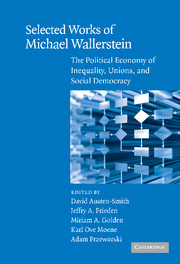 Selected Works of Michael Wallerstein
Selected Works of Michael Wallerstein Published online by Cambridge University Press: 27 January 2010
Introduction
Governments collect and spend on average around 45 percent of GDP in advanced industrial societies, and about half of government spending goes to fund the various expenditures on transfer payments and services that constitute what is commonly called the welfare state. Perhaps the most common view of welfare spending is that these policies are the outcome of a long political struggle in which workers and their allies used the power of the ballot box to obtain some redress for the inequalities generated by the market. In the words of Huber and Stephens: “The struggle of welfare states is a struggle of distribution, and thus the organizational power of those standing to benefit from redistribution, the working and lower middle classes, is crucial.” Other scholars have emphasized the political influence of the beneficiaries of welfare spending who are outside the labor market, such as the elderly. But whether the key groups are defined by class position, income, or age, most scholars have viewed welfare policies in redistributive terms.
The redistributive view of welfare policy, as formalized in a series of papers by Romer, Roberts, and Meltzer and Richard, implies that higher inequality of market incomes generates higher levels of political support for redistributive policies. The basic intuition is that low-income earners have more to gain and less to lose than do persons with high incomes from expansions of welfare spending. Thus, the poorer the majority of voters relative to the average income, the greater the expected support for welfare expenditures.
To save this book to your Kindle, first ensure [email protected] is added to your Approved Personal Document E-mail List under your Personal Document Settings on the Manage Your Content and Devices page of your Amazon account. Then enter the ‘name’ part of your Kindle email address below. Find out more about saving to your Kindle.
Note you can select to save to either the @free.kindle.com or @kindle.com variations. ‘@free.kindle.com’ emails are free but can only be saved to your device when it is connected to wi-fi. ‘@kindle.com’ emails can be delivered even when you are not connected to wi-fi, but note that service fees apply.
Find out more about the Kindle Personal Document Service.
To save content items to your account, please confirm that you agree to abide by our usage policies. If this is the first time you use this feature, you will be asked to authorise Cambridge Core to connect with your account. Find out more about saving content to Dropbox.
To save content items to your account, please confirm that you agree to abide by our usage policies. If this is the first time you use this feature, you will be asked to authorise Cambridge Core to connect with your account. Find out more about saving content to Google Drive.